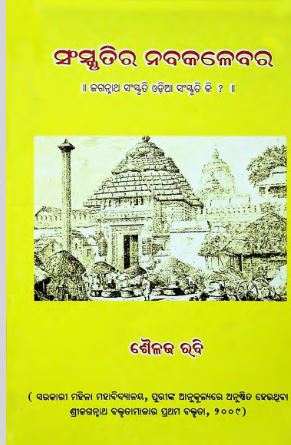In the vibrant tapestry of Indian culture, Odisha’s heritage stands out for its unique amalgamation of rituals, traditions, and the arts. The essence of this rich heritage is meticulously captured in Sailaja Rabi’s seminal work, “Sanskrutir Nabakalebar.” As an essay collection, this book offers a profound exploration of Odia culture, with a specific focus on the annual rituals of Lord Jagannath. Published initially in 2013, and republished in 2015, the second edition delves even deeper, offering fresh insights and reflections.
“Sanskrutir Nabakalebar” translates to “The New Body of Culture,” a title that aptly reflects the book’s exploration of renewal and continuity within Odia traditions. Sailaja Rabi, an accomplished writer and cultural enthusiast, presents these essays with a narrative flair that is both scholarly and accessible. Each essay is a window into the timeless customs that define Odia identity, probing into their historical origins and contemporary relevance.
At its heart, this book emphasizes the annual ritual of Nabakalebara in Puri, where the sacred idols of Lord Jagannath, Balabhadra, and Subhadra assume new forms. This intricate event, loaded with deep-seated symbolism, reflects the notion of rebirth and continuity. Through her essays, Rabi brings to life not only the grandeur of the ceremonial process but also the spiritual significance that pervades this vibrant festival.
Her essay titled “Nabakalebara: The Eternal Cycle” is particularly insightful, meticulously detailing the craftsmanship involved in the creation of new idols and the emotional resonance felt by millions of devotees. With every page, readers become part of the intricate wooden-carving tradition, accompanied by the soul-stirring chants and collective fervor that mark this ancient practice.
Beyond the rituals surrounding Jagannath, Rabi’s essays traverse multiple facets of Odisha’s cultural landscape. From dance forms like Odissi to the rhythmic beats of the traditional drums, from the vivid murals on temple walls to the intricacies of local handicrafts, no aspect is left unexplored. Each essay functions as a mosaic piece, forming a complete picture when viewed collectively.
One of the standout essays, “The Weaver’s Magic,” delves into the fascinating world of Odishan handlooms. Rabi sheds light on the symbiotic relationship between cultural motifs and the weavers’ creativity. The traditional looms, she reveals, are more than tools for weaving cloth; they are instruments of cultural preservation.
What sets “Sanskrutir Nabakalebar” apart is the blend of academic rigor and personal passion that Sailaja Rabi brings to her writing. Each essay is backed by meticulous research and enriched by anecdotal narratives, making the book both informative and engaging. It caters to a diverse readership, from scholars seeking a deep dive into Odia culture, to casual readers curious about the traditions of Odisha.
“Sanskrutir Nabakalebar” is more than just a book; it is a cultural journey that entices readers to explore the richness of Odisha. Sailaja Rabi’s insightful essays serve as a cultural bridge, connecting the reader to the heart of Odia heritage and the universal themes of renewal and continuity. The dual publications in 2013 and the enhanced second edition in 2015 signify the timeless relevance of this work. “Sanskrutir Nabakalebar” is an indispensable read for anyone interested in understanding the profound cultural ethos that defines Odisha and, by extension, the diverse cultural tapestry of India.
Books Info
| Books name | Sanskrutir Nabakalebar |
| Author | Sailaja Rabi |
| No Of pages | 58 |
| Publisher | Shabdaloka |
| Publication | 2013, 2015, 2e. |
| Printed At | Janup Graphix |
| Distributor | NA |

